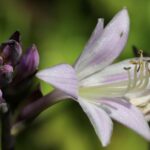The pruning and trimming of amaryllis

Pruning and trimming are essential maintenance practices in the lifecycle of an amaryllis, though they are quite different from the complex pruning required by many other plants. For the amaryllis, these tasks are simple, targeted, and strategically timed to support the plant’s health and encourage its natural growth cycle. The primary focus of trimming is the timely removal of spent flowers and stalks, as well as the management of foliage as the plant transitions into and out of its dormant period. Proper trimming ensures the plant directs its valuable energy towards the most productive ends: strengthening the bulb and preparing for future blooms, rather than wasting it on seed production or dying leaves.
The first and most immediate pruning task arises as the magnificent flowers begin to fade. As each individual bloom wilts and closes, it is beneficial to remove it promptly. This can be done by simply pinching or snipping it off at the small stem that connects it to the top of the main flower stalk. The reason for this practice, known as deadheading, is to prevent the plant from diverting its energy into the development of seeds. If left on the stalk, a pollinated flower will begin to form a large seed pod, a process that consumes a significant amount of the bulb’s energy reserves—energy that is far better spent on nourishing the bulb itself.
Once all the flowers on a single stalk have finished blooming and have been removed, the entire stalk will begin to yellow and wither. It is important to allow this process to happen naturally. The plant will reabsorb nutrients from the dying stalk back into the bulb. You should wait until the stalk has turned mostly yellow or brown and has become soft and limp. At this point, you can prune it back to about two to three centimeters above the neck of the bulb using a clean, sharp knife or pruning shears. Attempting to remove a green, healthy stalk can create a large wound that is susceptible to infection and can damage the top of the bulb.
It is crucial to differentiate between the flower stalk and the leaves. While the spent flower stalk should be removed, the long, green, strap-like leaves that emerge from the bulb must be left untouched. These leaves are the plant’s engine for the coming months. They are responsible for photosynthesis, the process of converting light into energy, which is then stored in the bulb for the next flowering season. Cutting these leaves off prematurely after flowering is one of the most common and critical mistakes in amaryllis care, as it effectively starves the bulb and will prevent it from reblooming.
Managing foliage during the lifecycle
The management of amaryllis foliage is a process of patient observation rather than active pruning for most of the year. During the post-flowering vegetative growth phase, the leaves should be allowed to grow to their full potential. Your role during this time is not to trim them, but to provide them with the best possible conditions—ample light, water, and nutrients—so they can perform their energy-producing work efficiently. Healthy, vibrant green leaves are a sign of a thriving plant that is successfully building up reserves for its next magnificent floral display. Any trimming during this phase should be limited to snipping off the tips if they happen to become brown or damaged.
More articles on this topic
The only time that significant pruning of the foliage occurs is when you are preparing the plant for its dormant period in the late summer or early autumn. This process should be guided by the plant itself. As you gradually reduce watering to induce dormancy, the leaves will naturally begin to lose their vigor, turning yellow and starting to wither. It is essential to allow this to happen on its own schedule. The plant is intelligently salvaging mobile nutrients from the dying leaves and pulling them back into the bulb for storage.
Once the leaves have turned completely yellow or brown and are dry and papery, they can be safely removed. At this stage, they will often pull away from the bulb with a gentle tug. If they still offer some resistance, you can use clean scissors or pruning shears to cut them off about five centimeters from the top of the bulb. This removal of dead foliage tidies up the plant and formally marks the beginning of its dormant period, during which it will require no further pruning or maintenance until it is time to reawaken it.
When the dormant period is over and new growth begins, there is no pruning required. You should allow the new leaves and flower stalk to emerge and develop naturally. The cycle begins anew, and the only trimming you will need to perform will be the deadheading of spent flowers and the eventual removal of the flower stalk once the show is over. This disciplined and minimalistic approach to pruning is perfectly suited to the natural rhythms of the amaryllis.
Trimming roots during repotting
While foliage and flower trimming are the most frequent pruning tasks, there are occasions when trimming the roots is also necessary and beneficial. The best time to inspect and prune the roots is during the plant’s dormant period, just before you are about to repot it for the next growing season. When you carefully remove the bulb from its old pot, you have a clear opportunity to assess the health of its root system. Healthy amaryllis roots are typically plump, firm, and whitish in color.
More articles on this topic
During your inspection, look for any roots that are dead, damaged, or diseased. Dead roots will appear brown or black, feel dry and brittle, or be soft and mushy if they have rotted. Using a pair of clean, sterilized pruning shears or sharp scissors, carefully trim away any of these unhealthy roots. This cleanup is important because dead and decaying root matter can harbor pathogens in the soil, which could potentially infect the healthy parts of the root system or the bulb itself after repotting.
It is also acceptable to lightly trim otherwise healthy roots if the root ball has become excessively large and tangled. This can make it easier to fit the bulb into a new pot without damaging the roots. When doing this, try to remove only the very ends of the longest roots, taking off no more than a few centimeters. This type of light pruning can also stimulate the plant to produce new, vigorous root growth once it is repotted and begins its active growth cycle.
After any root pruning, it is a good practice to allow the bulb to sit out in a dry, well-ventilated area for a day or so before you repot it. This allows the fresh cuts on the roots to dry and form a callus. This callusing process seals the wounds and creates a protective barrier, significantly reducing the risk of soil-borne fungi and bacteria entering the roots and causing rot once the bulb is back in its moist potting medium. This small step provides an extra layer of protection for the newly repotted plant.


















